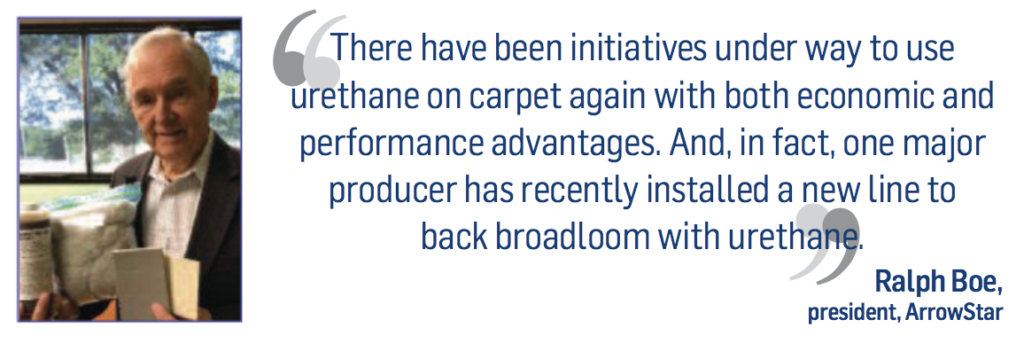October 15/22, 2018: Volume 34, Issue 9
By Steven Feldman
 Ralph Boe has built a career manufacturing carpet. Now, through a new venture, his focus is on the aftermarket for PET carpet. As president of ArrowStar, a company that has produced chemicals for the carpet industry for 20-plus years, Boe has formed Arropol Chemicals, which will produce polyol—a component for urethane—derived from the deconstruction of post-consumer polyester carpet.
Ralph Boe has built a career manufacturing carpet. Now, through a new venture, his focus is on the aftermarket for PET carpet. As president of ArrowStar, a company that has produced chemicals for the carpet industry for 20-plus years, Boe has formed Arropol Chemicals, which will produce polyol—a component for urethane—derived from the deconstruction of post-consumer polyester carpet.
“We’ve been developing this for the last four years,” Boe said. “After the carpet fiber is separated from the backing, it’s cleaned to a certain level of purity. Then we further process it to a state to feed a chemical reactor. It is chemically decomposed in the reactor and further reacted with other chemicals at high temperature to produce the polyol. It’s filtered, packaged and then shipped for use in producing urethane.”
There are two key components to making a urethane: polyol and an isocyanate. The main applications for the urethanes range from rigid foam panels and spray foam insulation in a home replacing fiberglass insulation; underlayment for flooring; or more flexible foam for slab stock used in furniture cushions.
Boe believes there are three competitive advantages to Arropol’s polyol compared to what’s already on the market:
- Economics. “We are actually able to make this polyol at a low enough cost to compete with virgin materials,” he said.
- Performance. “We have demonstrated better density in the underlayment so you get better performance from the carpet or hard surface flooring that’s being installed above it.”
- Environmental. “You are reducing the total carbon footprint because you’re no longer using as much virgin material and you’re recycling something that would otherwise have gone into the landfills.”
Arropol’s manufacturing facility is located in Dalton. “Right now we have one reactor that can produce about 3 million pounds of polyol a year,” Boe said. “We obviously have to get the carpet and have it processed. We’re concentrating on California carpet since there is a legislated requirement to recycle a defined percentage of what’s being pulled up there to avoid the landfills.”
Finding aftermarket uses for PET carpet and keeping it out of landfills has been a major issue for the industry as PET has taken significant share from nylon in the 2000s. “There has been a problem trying to figure out how to recycle polyester,” Boe told FCNews. “Carpet pull-ups in California exceed 400 million pounds a year with the criteria for CARE to get 25% of that recycled annually, which means you have to recycle about 100 million pounds. We think we can very quickly be consuming 10% of that once we get this reactor and an additional one operating. If the demand exceeds that, we can continue to expand.”
With the California legislation, there are incentives used to encourage collectors, processors and manufacturers to move forward quickly. Arropol will count on collectors and processors to provide the PET fiber or chip to process into polyols.
Arropol has had discussions with potential customers that make underlayment, spray foam, rigid foam panels and slab stock. “Not every carpet mill is a potential customer, but synthetic turf manufacturers use urethane-backed carpet,” Boe noted. “There have been initiatives under way to use urethane on carpet again with both economic and performance advantages. One major producer recently installed a new line to back broadloom with urethane.”
Boe believes there is an extremely large opportunity with spray foam insulation. “Contractors buy the polyol and the isocyanate. We’ll sell just polyol and they get the isocyanate from other chemical companies.”
Arropol has been ready to roll with production but was awaiting EPA approval. “We’ve shipped product for market development, but we hadn’t been able to ship with commercial continuity,” Boe explained. “You have to make sure there aren’t any hazards involved in the production or environmental issues with its use. We’ve completed that process over the last nine months and finally received formal sign-off from the EPA on Oct. 5. Now we can begin manufacturing and shipping commercially.”
